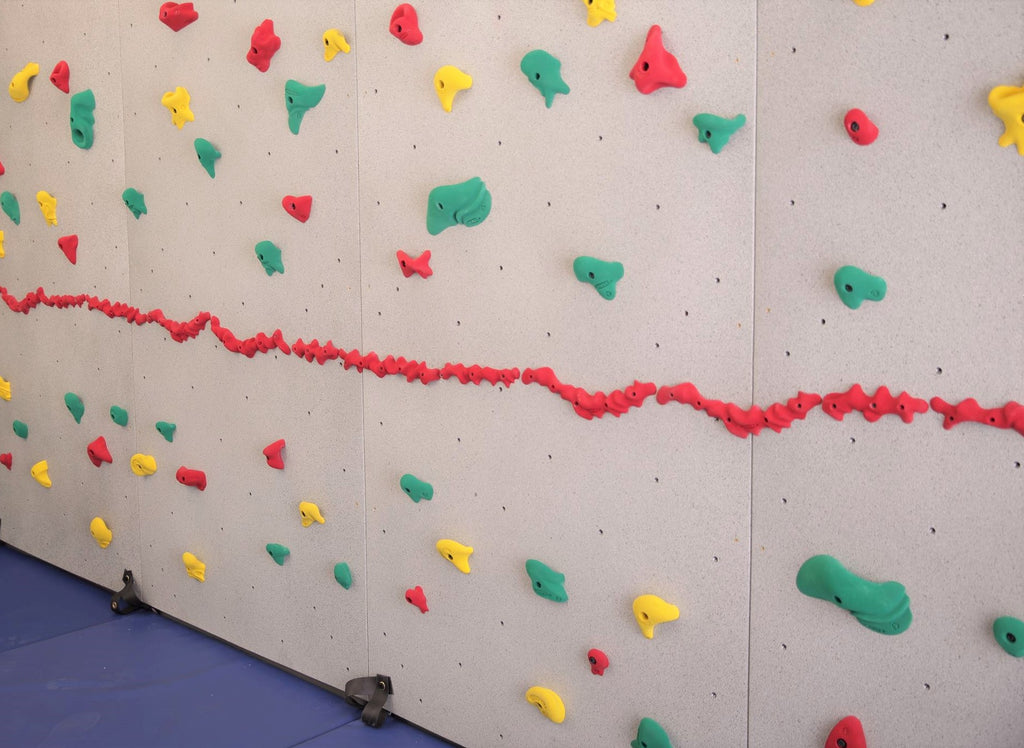
Reset Your Climbing Wall This Summer
Summer is a great time to reset your climbing wall. To help you out, we are reposting our Climbing Wall Route Setting Fundaments that we originally shared in September of 2019.
Climbing Wall Route Setting Fundamentals
It’s a good idea to move the location of your hand holds periodically to keep the climbing wall interesting and challenging for climbers over time. In doing so, you can create specific climbing routes, of varying difficulty levels, for climbers to try.
Many people wonder "What is a climbing route?" and "How do I go about setting climbing routes?" We are here to help!
What Is a Climbing Route?
A climbing route is a specific path the climber must follow to reach the top, or end, of a climb.
How Are Climbing Routes Marked?
Routes can be marked with tape next to holds that are on the route. Or the same color hand hold can be used throughout a route. Most of our climbing walls include color-coded hand holds which makes it easier to set routes by color. Each color corresponds to a certain difficulty level enabling route setters to set climbing routes of varying degrees of challenge. Here's the key to our color coding system:
- Green holds (beginner) = larger size and easiest to grip
- Yellow holds (intermediate) = various sizes and range from easy to grip to challenging
- Red Holds (advanced) = medium to small size and challenging to grip
- Blue Holds (experienced) = the most technical holds (only included on 10'-high Traverse Walls® and Top Rope Walls)
What Should I think about before Setting a Climbing Route?
- Age and ability of climbers
- Size(s) of climbers. How long are their legs and arms?
- Are holds at the beginning and end of the climbing wall positioned to allow climbers to get on and off the wall easily?
- How you position a hold on the climbing wall can affect its difficulty level. Generally there is an easier and harder way to position the climbing hold on the rock wall.
What Makes a Good Rock Climbing Route?
- Safety
- The climber should not be required to climb too high (on a Traverse Wall) or to make moves that put him/her in awkward or off-balance positions
- The route should be climbable for people of varying heights
- Variety
- Involves a variety of different climbing moves
- Involves a variety of hand and foot placements
- Uses most of the climbing wall
- Requires some interesting or unusual moves
- Difficulty Level
- The difficulty level should be consistent throughout the entire route, from start to finish
- Keep the skill and experience of participants in mind and create routes that challenge and engage, but that do not frustrate
What Should I Avoid When Setting Climbing Routes?
- Too challenging, for example, with not enough holds on the route making it too hard to get from hold to hold
- Boring with too many of the same climbing moves
How do I Get Started Route Setting on a Traverse Wall?
If your climbing wall includes a Red-Relief Line®, but sure that is installed first.
- Unpack hand holds and separate them by size and color.
- Begin with the green holds. Mount holds that will be used for feet and for hands. Space them to create a beginner-level route that will not require much stretching or challenging moves. Vary the location of the smaller/larger holds. Be sure they span entirely from one end of the wall to the other. Try it out as you create the route to make sure it’s climbable. Keep the age/size/reach of climbers in mind.
- Next mount the yellow holds in a similar way, creating an intermediate-level route. Next mount the red holds in a similar way, creating a more advanced/challenging route. If your wall includes blue holds, mount them next. This will be another advanced route.
What If I need More Help Setting Climbing Routes?
If you would like more detailed guidance with route setting on your Traverse Wall, we offer a Traverse Wall Route-Setting Guide for purchase. This one-of-a-kind guide takes you step-by-step through the route setting process. It includes an introduction to the route setting process, route maps, hand hold installation instructions and other resources. The route maps show exactly where to place hand holds, which greatly simplifies the route setting process. Keep in mind that the guide is compatible only with Groperz Route-Setting Hand Holds and certain climbing walls manufactured by our company.

Leave a comment